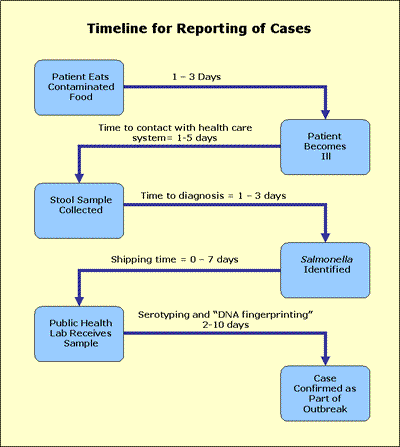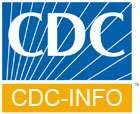Skip directly to the search box, site navigation, or content.
Salmonella Outbreak Investigations: Timeline for Reporting Cases
To find cases in an outbreak of Salmonella infections, public health laboratories serotype the Salmonella bacteria and perform a kind of “DNA fingerprinting” on Salmonella laboratory samples. Investigators determine whether the “DNA fingerprint” pattern of Salmonella bacteria from one patient is the same as that from other patients in the outbreak and from the contaminated food. Bacteria with the same “DNA fingerprint” are likely to come from the same source. Public health officials conduct intensive investigations, including interviews with ill people, to determine if people whose infecting bacteria match by “DNA fingerprinting” are part of a common source outbreak.

A series of events occurs between the time a patient is infected and the time public health officials can determine that the patient is part of an outbreak. This means that there will be a delay between the start of illness and confirmation that a patient is part of an outbreak. Public health officials work hard to speed up the process as much as possible. The timeline is as follows:
1. Incubation time: The time from eating a contaminated food to the beginning of symptoms. For Salmonella, this is typically 1-3 days, sometimes longer.
2. Time to contact with health care provider/doctor: The time from the first symptom until the person seeks medical care, when a diarrhea sample is collected for laboratory testing. This time may be additional 1-5 days, sometimes longer.
3. Time to diagnosis: The time from when a person gives a sample to when Salmonella is obtained from it in a laboratory. This may be 1-3 days from the time the sample is received in the laboratory.
4. Sample shipping time: The time required to ship the Salmonella bacteria from the laboratory to the state public health authorities that will perform serotyping and “DNA fingerprinting”. This usually takes 0-7 days depending on transportation arrangements within a state and the distance between the clinical laboratory and the public health department. It should be noted that the diagnostic laboratories are not required by law to forward Salmonella isolates to the public health labs and not all diagnostic laboratories forward any isolates unless specifically requested.
5. Time to serotyping and “DNA fingerprinting”: The time required for the state public health authorities to serotype and to perform “DNA fingerprinting” on the Salmonella and compare it with the outbreak pattern. Serotyping may take up to 3 days. The “DNA fingerprinting” can be accomplished in 2 working days (24 hours). However, many public health laboratories have limited staff and space, and experience multiple emergencies at the same time. Thus, this process may take 1-10 days for both serotyping and "DNA fingerprinting" together.
The time from the beginning of the patient’s illness to the confirmation that he or she was part of an outbreak is typically about 2-3 weeks. Case counts in the midst of an outbreak investigation are therefore always preliminary and must be interpreted within this context.
Content Source: National Center for Zoonotic, Vector-Borne, and Enteric Diseases (ZVED)
Quick Links
Contact CDC

